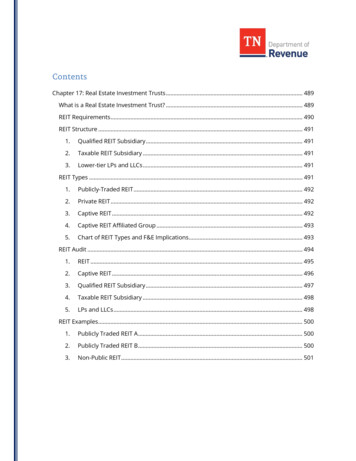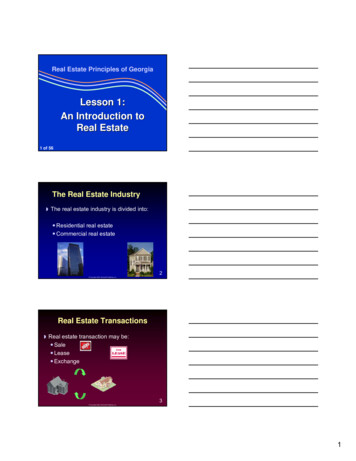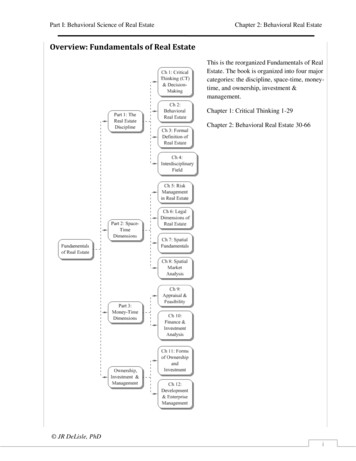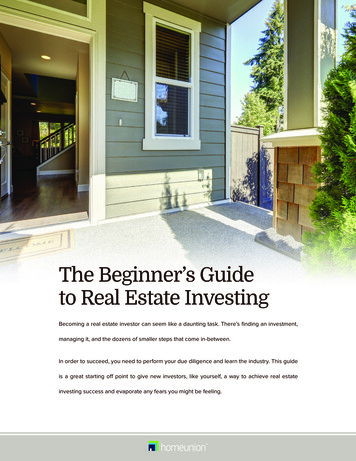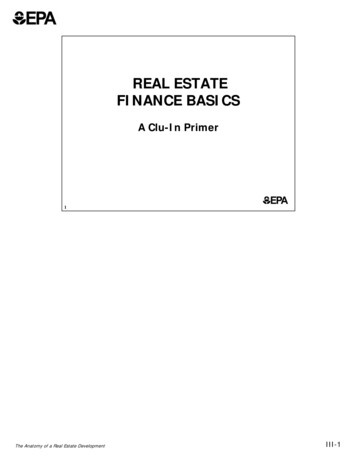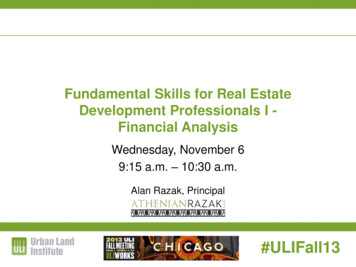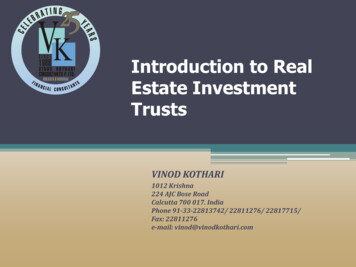
Transcription
Introduction to RealEstate InvestmentTrustsVINOD KOTHARI1012 Krishna224 AJC Bose RoadCalcutta 700 017. IndiaPhone 91-33-22813742/ 22811276/ 22817715/Fax: 22811276e-mail: vinod@vinodkothari.com
2Real estate securities Reasons for adding real estate in investment portfolio: Real estate is globally the biggest asset Presumption is that real estate has low correlation with the rest of financialsecurities Investing in real estate has several problems Availability Ticket size Management problems Hence, intermediated investment through real estate securities cameup Real estate securities include: REITsREOCsMortgage-backed securitiesETFs/ real estate mutual fundsSynthetic investment by investing in real estate indicesPresentation on REITs by Vinod Kothari
3Meaningof REITs A collective investment device of commercial real estate Equity-type funding REITs versus CMBS: CMBS is securitised debt lending against real estate REITS are security equity funding of real estate REITs Owns, and in most cases operates, income-producing property(Equity REITs) OfficeApartmentRetail (shopping centers)HotelsWarehouses (storage) Some REITs also finance real estate (Mortgage REITs) Essentially a tax-tool where equity funding of real estate isallowed on tax transparent basis: Minimum 90% dividend REITs are typically listed and quotedPresentation on REITs by Vinod Kothari
4REITs as property investment vehicleReal Estate InvestmentDirect InvestmentListedIndirect InvestmentNon-listedClose-End FundsProperty StocksREITsPartnershipsCommingled Funds Syndication, JVs, TICOpen-End FundsFund-of-FundsMutual FundsSpecial FundsHedge FundsREITsREITs have some 34% sharein listed property investments.Presentation on REITs by Vinod Kothari
5Commercial real estate as asset classExhibit 1: More bricks than bondsDeveloped economies' stocks of assets end 2002 ( trillion)Residental propertyEquitiesCorporate bonds01020304050Source: The EconomistPresentation on REITs by Vinod Kothari
6Typical REIT structurePresentation on REITs by Vinod Kothari
7REITs and Mutual funds/ collective investmentschemes While mutual funds may be open-ended, REITs areclosed-end funds. As such, REITs are typicallylisted and their market values may or may not betheir NAVs. Owing to nature of their assets, computation ofNAVs by REITs is different from that by securitiesmutual funds REITs are income-oriented Investors relying on regular income have incentiveto invest in REITs Statutorily, REITs distribute substantial part of theirtaxable profitsPresentation on REITs by Vinod Kothari
8Major Player/Capital Sources: Equity: REITs are major sources of equity for real estate, mainly commercial realestate today JP Morgan Asset management estimates total investment grade, incomeproducing CRE in the USA to be USD 6.4 trillion 3.5 trillion debt2.9 trillion equity5.9 trillion private0.5 trillion public of the USD 2.9 trillion equity, approx USD 500 billion is owned by REITs Global estimate of investment grade CRE is 26.6 trillion (2011): Europe 9.4 trillion,US/Canada 7.5 trillionAsia-Pacific 7.2 trillionLatin America 1.8 trillion)GCC: 677 billion [Prudential Real Estate Investors data]Presentation on REITs by Vinod Kothari
9Suppliers of CRE debt 2013 data indicatesbanks holding 35%CRE debt, followed byCMBS/CDOs holding23%, GSEs /MBSabout 16%[http://housingamerica.org/RIHA/RIHA 0-7-09).pdfPresentation on REITs by Vinod Kothari
10Major Player/Capital Sources: DebtBanksCMBSLife Co.Federally Guar.PoolsOtherPresentation on REITs by Vinod Kothari
11REITs by country The number of REITs globally, end-June 2008 stood at 451 (E&Y 2008REIT Annual). Down from 484 end 2006 Decline mostly accountable by US debacle – number down from 253 in2006 to 148 in 2008 In terms of market cap, the most significant REIT countries, in order ofsignificance, are USAAustraliaFranceUKJapanCanadaSingaporeAnd so onPresentation on REITs by Vinod Kothari
12REITs global dataREITS data in different countriesCountryMarketTotal rate ofTotal rate ofWeightedcapitalizationreturn — onereturn — threeaverageUS millionsyear (%)years (%)dividendyield (%)United .7France64,52645.5-9.60.2United erlands11,23440.9-6.0*Hong Kong9,51864.59.98.1Belgium6,76117.2-2.41.4South Africa3,40017.512.48.5New ia1,54238.610.23.7Germany71345.5N/A*South Korea13228.412.18.4* Insufficient data for Germany, the Netherlands and TurkeyPresentation on REITs by Vinod Kothari
13REITs market cap over years 34 countries have REITs as of2013 Number has increased over timeas many countries have enactedREIT legislation South Africa and Irelandrecently passed legislations About two dozen morecountries are planning to haveREITs India has come with a draftREIT regulation from SEBIPresentation on REITs by Vinod Kothari
14REITs market cap in the USA5,00,000.002504,50,000.00Market Cap4,00,000.00No of r’s graph based on data on reit.com0Presentation on REITs by Vinod Kothari
15Market capitalisation per REITPresentation on REITs by Vinod Kothari
16US REITs capital issuesFrom reit.comPresentation on REITs by Vinod Kothari
17REITs by regionSource: EY’s Global REIT report Oct 2006Presentation on REITs by Vinod Kothari
18REITs by countryTotal number of REITs by countryGlobal y2NAFrance4830Turkey13NAUnited Kingdom19NA676458864238Hong Kong74South Korea611Malyasia1311Singapore2011451484United StatesNorth AmericaCanadaNetherlandsEMEIA (EMEIA is a global region made up ofEurope, Middle East, India and Africa.Note Indian REITs have not beenanalyzed in this report.)South AfricaAustraliaPacificNew ZealandJapanAsiaTotalPresentation on REITs by Vinod Kothari
19Market cap by countrySource: E&Y 2008 REITs annualPresentation on REITs by Vinod Kothari
20REITs in certain countries USA: REITs have been there since 1960 when taxrules were amended to permit REITs Apart from listed REITs, there are many unlistedREITs (about 1100) UK – REITs were a recent introduction. Provisionswere contained in Finance Act 2006 permittingproperty companies to transform into REITs Australia- they are known as listed property trustsand have been in existence for several years China: has taken an in-principle decision butREITs yet to be a reality in ChinaPresentation on REITs by Vinod Kothari
21Geographical distribution of REITsPresentation on REITs by Vinod Kothari
22REITs returns Till 2008, REITs performed very badly due toglobal property meltdown In 2009, REITs have been recovering Though in most cases they are still below 2007 valuesS&P REIT quarterly report Q3 2009Presentation on REITs by Vinod Kothari
18001600140012001000800600400200001-10- 01-07- 01-04- 01-01- 01-10- 01-07- 01-04- 01-01- 01-10- 01-07- 01-04- 01-01- 01-10- 01-07- 01-04- 01-01- 01-10- 01-07- 31-03- 31-12- 23Performance of REITsDJ Global Select REIT indexPresentation on REITs by Vinod Kothari
24Comparative REITs performancePresentation on REITs by Vinod Kothari
25Indicators of leverage Most REITs make use of leverage If REITs are tax transparent, use of leverage is akinto use of debt in a tax-free world Significance debt/assets ratios in some countries(2008): Canada 0.69USA: 0.64South Korea 0.56Germany 0.52France 0.49Japan 0.48Netherlands 0.47Australia 0.45Presentation on REITs by Vinod Kothari
26REITs leverage dataPresentation on REITs by Vinod Kothari
27REIT capitalisation and property NAVThe difference may be explained by accounting differences – under US GAAPinvestment property is held at cost, while under IAS 40, revaluation modelis permittedPresentation on REITs by Vinod Kothari
28Measure of volatility
29Where did REITs come from? REIT is essentially a tax termCreated in 1960 (act of Congress) as a way to make propertyinvestment available to individual investors Offer expert management and familiar corporate governance structures(BOD)REITs make equity interest in commercial property:1.2.Divisible into shares that can be purchased by small investorsLIQUID – the shares trade on major exchangesPresentation on REITs by Vinod Kothari
30REITs as a force in the CRE finance In USA, about 15-20% of investment grade CRE isheld by REITs About 24000 properties 169 REITs trade on NYSE 35 REITs are in S&P 500Presentation on REITs by Vinod Kothari
31REITs in different countries Many countries have adopted a REIT-type structure: France - SIICLPT - Listed Property Trusts (Australia)Dutch FBI - Fiscal Beleggings Instelling (Netherlands)S-REIT – Singapore Real Estate Investment TrustJ-REIT - Japanese Real Estate Investment TrustCanadian REITs – Legislated in 1993, growing universeBelgium REITs – Growing universeHong Kong REITs – Largest REIT IPO Completed in November 2005Bulgarian REITs – Newest country with REIT legislationMalaysian REITs – Growing universeProperty unit trusts – South AfricaUK Finance Act 2006 has provided for conversion of qualifying companiesinto REIT status from 2007Presentation on REITs by Vinod Kothari
32Types of REITs Equity REITs Own and operate income-producing real estate Perform leasing, development, and construction activities As of 31.12.2005 152 publicly traded equity REITs, with market cap of 301 billion, about 90% ofthe market Mortgage REITs Hold mortgages on real property Make mortgages (lend money), usually on existing propertyBuy mortgages27 publicly traded mortgage REITs Hybrid REITs Both own properties and make loans 8 publicly traded Hybrid REITsPresentation on REITs by Vinod Kothari
33Types of REITs – by propertyPresentation on REITs by Vinod Kothari
34Why investors invest in REITs Diversification Asset allocation objectives puts real estate as a must DividendsLiquidityPerformanceLiquidityReal property backingPresentation on REITs by Vinod Kothari
35Components of REITs total returnsPresentation on REITs by Vinod Kothari
36Performance of REITsPresentation on REITs by Vinod Kothari
37Correlation of real estate and financialsecuritiesPresentation on REITs by Vinod Kothari
38Portfolio allocation by REITs Geographical diversification Unlike financial markets, property markets have a weakglobal correlation Global property diversification is not possible for anindividual investor Stress on income vs market value: Dividend payout is one of the characteristics of REITs Property typePresentation on REITs by Vinod Kothari
39Investing in REITs General desire to have a portion of assets in real estate Typically, 8 -10% real asset allocation Asset price bubbles may be a cause for concern Reits distribute more regular income – why? If you are holding property, and want to sell it in future, you may short REITs indexIf you wanting to buy property, you may long REITs index REITs are, however, more volatile than property prices (due to public trading) (see slide)REITs have relatively higher correlation with equities than real estate prices A diversified investment in bricks Weaker correlation with financial securities Dividends: Exchange-traded funds investing in REITs indices may allow investors to take anexposure in a REITs index Hedge against properties: Allows investors to take a view on property price indices Have produced better returns than private investment in real estate (next slide) Downsides:Presentation on REITs by Vinod Kothari
40Distinctive features of investing in REITs Is it an income stock or growth stock REITs are essentially income stocks: Dividend restrictions Mostly, REITs will invest in mature income producingproperties REITs in most countries are not allowed to get intodevelopmentPresentation on REITs by Vinod Kothari
41REIT returns (NAREIT index) versus private investment inproperty returns (NCREIF index)35%30%25%20%15%10%5%0%3 Months*1 Year3 Year5 YearNCREIF Property10 Year15 Year20 YearNAREIT-AllPresentation on REITs by Vinod Kothari
42NAVs and REIT valuesSource: E&Y 2008 REIT annualPresentation on REITs by Vinod Kothari
43REITs versus NCREIF - volatilityREITs vs NCREIF NCREIF92949698000204NAREITPresentation on REITs by Vinod Kothari
44Other real estate investment vehicles Direct investment properties Property funds: Closed-end funds open-end funds REIT ETFs Property derivatives: Total return swaps linked to properties Swaps linked to property indices Housing futures For example, CME Housing futures On S&P Case Schiller Home price index CMBXPresentation on REITs by Vinod Kothari
45Real estate price on on REITs by Vinod Kothari
46Parameters in evaluating a REITinvestment Price to FFO: REITs price/FFO is generally lower than corporate P/E ratios: Is this justified? Price to NAV: Depending on the cycle, REITs may be trading at premium on NAV ordiscount on NAV For last several years, REIT prices have been trading at premium on NAV Scale: Smaller REITs will not be able to achieve diversification and economies ofscale Vertical integration Property groups with development, management and financing activitiesare generally preferredPresentation on REITs by Vinod Kothari
47Growth opportunities How does a REIT grow? Since there are dividend distributionrequirements, REITs cannot grow the waycorporates grow Hence, REITs have to continuously look for: Capital issuance Debt issuance Leverage is also limited If the REIT is already fully geared, it cannot use furtherdebt Hence, ability to issue further capital becomescriticalPresentation on REITs by Vinod Kothari
48REIT Structures –UPREITs and Traditional REITs UPREIT (Umbrella Partnership REIT) First UPREIT was Taubman Realty IPO in 1992 UPREIT structure created to shield owners contributing real estateassets to the REIT from capital gains taxes on contributed property Transfer is then partnership shares for partnership shares, and this is nota taxable event for the owners UPREIT owns a controlling interest in a limited partnership thatowns the real estate, as opposed to a traditional REIT structure inwhich the REIT owns the real estate The Umbrella Partnership “shares” – known as operatingpartnership units, or OP units – are convertible into REIT sharesand enjoy voting rights and dividends just like REIT shares Convertibility allowed after one year, and triggers taxesPresentation on REITs by Vinod Kothari
49REITs and Taxes REITs do not have to pay federal taxes at thecorporate level More specifically, REITs are allowed to deductdividends paid to shareholders from taxableincome, and thus have the ability to shield 100% oftaxable income through distributions toshareholders No other firm in the economy can deduct dividends REIT shareholders still have to pay taxes ondividends and capital gains Most states honor the REIT status and don’t requireREITs to pay state taxesPresentation on REITs by Vinod Kothari
50Tax restrictions on REITs Taxed in such a way that they usually distribute all their income. Must be owned by at least 100 people, no more than 50% ofequity Must derive at least 75 percent of gross income from rents fromreal estate or interest on mortgages on property Must invest at least 75 percent of its total assets in real estateassets 1031 exchange not allowed for investorsPresentation on REITs by Vinod Kothari
51US rules for taxation of reits Asset Test: At least 75% of a REIT’s asset valuemust come from real estate, cash, and governmentsecurities at the close of each quarter of taxable year No more than 5% of the value of the assets may consist of the securities of oneissuer, and REIT may not own more than 10% of the outstanding shares of one issuer, ifthose securities are not includable in the 75% test Income Test: At least 95% of gross incomemust come from dividends, interests, rents, or gains fromsale of certain assets No more than 30% of REITs gross income can be derived from sale of real estate held forless than fours years or securities held forless than six months Distribution Test: At least 90% of the REIT taxable incomemust be distributed to shareholders Stock and Ownership Test: REIT shares must be transferable and must be held by a minimum of 100 persons No more than 50% of REIT shares may be held by five or fewer personsPresentation on REITs by Vinod Kothari
52Reporting by REITs Funds from operations GAAP incomeExcluding gains or losses from sale of propertyPlus historical cost amortization of propertiesLess future taxes Adjusted funds from operations FFO minus recurring capital expenditure to maintain theproperty Straight-lining of rentals FFO and GAAP income reconciliationPresentation on REITs by Vinod Kothari
JP Morgan Asset management estimates total investment grade, income producing CRE in the USA to be USD 6.4 trillion 3.5 trillion debt 2.9 trillion equity 5.9 trillion private 0.5 trillion public of the USD 2.9
